|
Chapter XV
Five and a half years younger than Shane, Oona blossomed
when she had his company. They must have felt close in their pain, and
the quiet support they gave each other may have eased the ache of
abandonment they both suffered for so long. Oona was excited to have
Shane around whenever he came home to The Old House for his summer
vacations. He seemed very special to her, and generally kind and
big-brotherly to us both.
We loved going to the beach with Shane, where we could
spend the day at Jenkinson's Pavilion and the connected pool. I hadn’t
really known Shane much before and I grew to love him. This handsome
young cousin of mine was tall, slender and always very tan. He looked so
much like his illustrious father, with wide-set, dark brown eyes and a
high forehead. He had a kind of shy, lop-sided grin that always appealed
to me. I loved hearing him talk to us in his special quiet, soft voice.
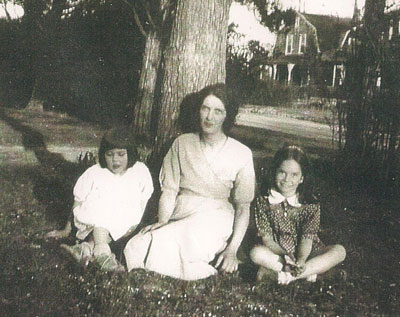 |
|
Budgie with Dallas and Oona in
Jersey. |
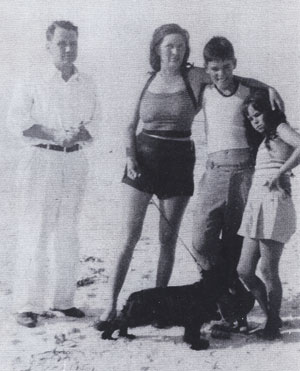 |
Jimmy,
Agnes, Shane and Oona with Middie dog. |
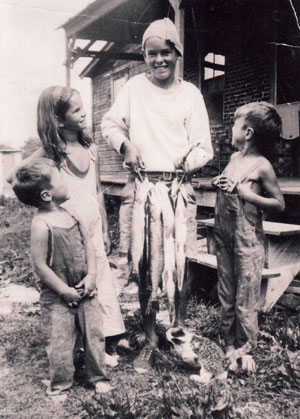 |
Shane with
his prize catch, with Oona and two unknown admiring boys. |
Jenkinson’s Pavilion, on the Point Pleasant beach,
became a real hangout for us every summer, as well as at times in the
spring and fall. It was a big part of our lives, and we would amble
along the boardwalk eating popcorn or ice cream, maybe stopping at the
Arcade to see who might be there that we knew. My favorite thing was
savoring the Italian ices and I still remember my favorite flavors,
honeydew and watermelon. There were times when I became distressed as Oona would take one bite from a cone, then throw it away, or buy a big
bag of popcorn, eat a little and toss the rest in the trash bin. Coming
from a home where every penny counted and they were hard to come by, I
couldn’t bear to see her do this. I wanted her to ask me if I would like
to take them home before she tossed them. I had been a child of the
Great Depression and later realized it had affected me. Oona and Shane’s mother and
father certainly had fewer financial worries during that time and the
children did not appear to be aware of such things.
Oona and I spent a great deal of time roller skating and
going to the boardwalk by the beach where skating down a large bumpy
ramp was the most fun of all. The wide ramp, made of heavy boards,
slanted from the boardwalk down to the sidewalk. It thrilled us to roll
down with the skates going clickety-clack all the way, with the hope
we'd be able to keep our balance as the ramp turned from wood to
concrete. We got a few bruised knees but it was worth the delight!
When Oona and I joined the Girl Scouts, the Pavilion
again became a special place. As Scouts we were learning the Morse Code
and how to tie knots of all kinds in the large school gymnasium, but
each Monday night we would go with our scout leaders down to the
boardwalk where Sammy Kaye and his orchestra took time from their
evening entertainment to play for us. They played for the Scouts for an
hour and a half, and we loved it as we learned to dance and “jitterbug.”
“Swing and Sway with Sammy Kaye” was the highlight of our scouting days.
Jenkinson’s Pavilion was where Sammy Kaye had his start, and we were
most excited when we heard him later on recordings over the radio.
Early one summer, Oona chose to buy a new rubber bathing
suit as it was the latest rage and quite stylish. We swam and played in
the pool at Jenkinson’s, when suddenly Oona backed up against the side.
She was very upset and called over, “Dallas, go get my big towel in the
bath house…quickly, please…!” This modern creation had split right up
the back!
The summers were full and we shared good times. Often on
the ride home from the beach, Shane would stop at the drugstore and
treat us to a Black Cow — root beer with vanilla ice cream. At the end
of the summer season it was difficult for Oona to see her brother leave
and go back to boarding school. Another abandonment. It must have been
equally as hard for Shane to leave and see Oona staying at home with
their mother.
In the fall of 1936, Agnes announced her plans to be away
from home for the entire winter, going to California and unable to take Oona with her. She rented a house in Key West, Florida, asking Budgie
and Nanna if they would take the family, along with Oona, down for the
school year. As part of the adventure, we were to travel south on the
train. The school principal talked to the family and suggested we go to
a parochial school in Florida, because the public schools in the south
were academically far behind the northern schools.
The train was exciting for Oona, Robert and me. I recall
a rather unusual snowstorm in Georgia as we went through, with another
strange memory being the dreadful taste of sulfur in the water on that
part of the trip. We could not bear drinking the water and made horrible
noises to show our dislike.
One other very disturbing thing on that part of our trip
were the chain gangs that we saw from the train as we traveled though
the deep South. Clad in black and white striped uniforms the prisoners
worked on the roadsides, chained to each other by shackles around their
ankles. The guards appeared big and ugly with rifles over their
shoulders. Budgie explained the scene and gave us a long remembered
lesson in prejudice and cruelty. Years later in teaching history through
music, I was able to relate this first hand to my students while using
traditional chain gang songs.
The bridge to Key West had been washed away in a severe
hurricane the year before and we traveled to the island on a ferryboat.
Once settled into the house on South Street, we found ourselves in a
neighborhood with lots of boys who came out of the woodwork when two
girls appeared on the scene. Oona and I were delighted, and my mother
dismayed, when a knock at the door produced a large box of paper hearts
cut from newspapers. Then we heard young voices outside the back
window singing songs in Spanish and calling out a word that sounded
like “Calinda.” Budgie said, “Do not ask
anyone what it means...it might be rude.” Of course we asked about it,
and found that our young admirers had been calling us “pretty.”
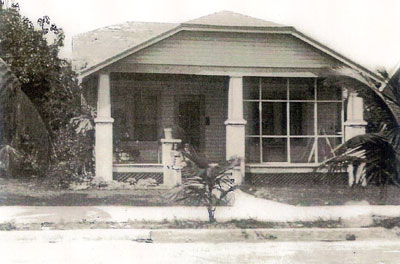 |
|
Key West, Florida, the house
on South Street, circa 1936-1937. |
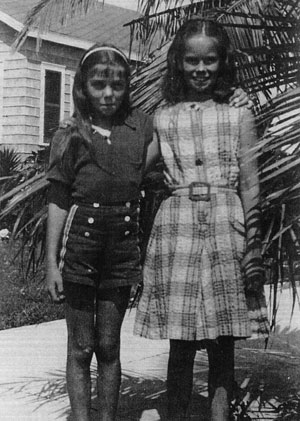 |
Dallas and
Oona. |
The sunny days in Key West were filled with good times.
We roller-skated on the sidewalks and Oona taught me how to ride a
bicycle. We spent happy hours swimming in turquoise water on a long
beach down the way from the Hemmingway house. Robert had found a friend
in an old man next door who took him out on his fishing boat almost
daily. The “Old Man” and his wife lived right next to us and they were
like treasured grandparents to a little boy who needed not only a father
figure but also good friends in his life.
|
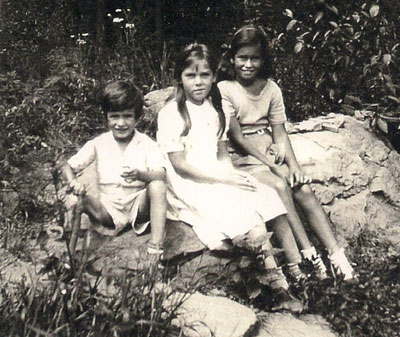 |
|
Key West
Winter, Robert, Dallas and Oona, circa 1936-1937. |
|
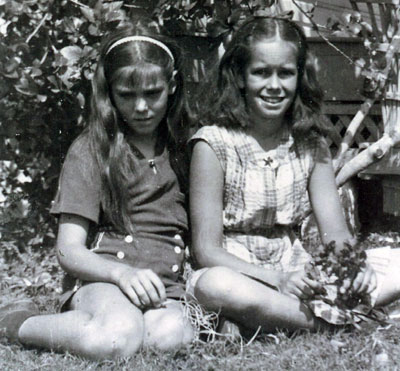 |
|
Dallas and
Oona. |
Soon came the season when small purple and gray stone
crabs covered the beach. Oona and I gathered up a dozen or so and put
them gingerly into a can we found. At home we divided them up into two
small cans so we each had a little “family.” We tied long strings around
two of the less fortunate creatures, so they became our “puppy-crabs”
while we followed them around the living room on their leashes. At night
they went back into the cans with screens on top, but by morning all had
escaped. For weeks Budgie and Nanna were finding stone crabs — dead and
alive — behind the couch, under the chairs and wherever they could hide.
Budgie made us return the live ones to the beach. So much for the poor
little critters. Could they ever forgive us?
At the convent where we attended school, Oona and I went
early each morning to wait outside the gates before classes began. We
hoped to have a quick look at a handsome young choirboy whose name we
had learned was Lewis. I doubt Lewis even knew that we existed, but it
was fun for us to dream about him at such tender ages. The nuns, dressed
in full habit, were strict but very loving. Sister Annette, who taught
me in fourth grade, cracked me across the knuckles with a ruler if I
persisted in talking with my neighbor, which happened quite often. For
some reason I still loved her and knew she wasn’t being cruel. Oona must
have been less chatty in class — she didn’t seem to have that problem.
When spring came and school was over, we headed back to New Jersey. Agnes
had returned from California and Shane was arriving home from boarding
school. Oona was happy to be home with her mother and Shane — the family
who came and went in her life. Looking back, I believe Oona often took
advantage of the two years between us to exert some control over me,
which may have helped in her frustration of having no control over an
abandoning family. She was able to direct me and I was always there, as
were Nanna and Budgie. The three of us were perhaps the only dependable
people in the life of this little girl who so desperately needed a
reliable and “always-there” family. But they were not her very own.
We had happily returned to the ochre house next door to
the O’Neills. Though having enjoyed our stay in Key West, it was good to
be home and see our old school friends. One late afternoon Robert and I
were playing table games when Nanna came in to tell us to come outside
and see the huge dirigible that was going over the house. She told us it
was the Hindenberg from Germany. It was very exciting to see it at such
close range. Nanna said it was coming down low because it would land
nearby in Lakehurst.
We went back in the house to finish our game in the
dining room. Suddenly we heard Nanna cry out, “Oh, no! Oh, no!” We raced
into the living room to see what had happened. The radio news reporter
was telling us the Hindenberg had just gone down in flames over
Lakehurst, and they were trying to get everyone off. It sounded like a
nightmare! Oona had also heard about it and came over from next door to
tell us the sad news. We all sat with Nanna and Budgie listening to the
grisly reports. It was hard to believe we had seen it just a short while
before, floating up there in the sky above us, when it had appeared so
quiet and peaceful. This was May 1937.
Our family had many relatives from New York who often
came down on weekends. They were not Boultons, but were a big part of
our lives and very interesting people. Once Uncle Owen Williams, Nanna’s
brother from the mid-west, came with his four children to visit. Marnie
took the train down from New York and joined us. We had a jolly and
memorable time, going to the beach and playing games.
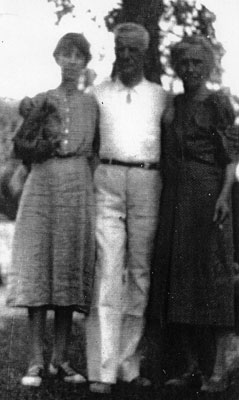 |
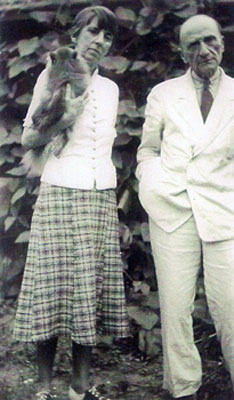 |
| Cecil
Boulton (right) with brother, Owen Williams and sister,
Margery Williams Bianco, 1940. |
Margery and
Francesco Bianco with Suzie dog, 1940. |
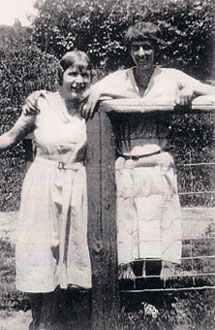 |
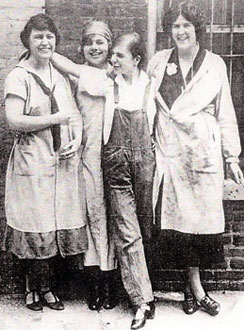 |
| Cousin
Pamela Bianco and Budgie. |
Pamela
(center), news clip with friends. |
Other relatives we really loved to see were Marnie and
Francesco’s grown daughter, Pamela Bianco. She was an artist and also
lived in the city. Oona would come over from The Old House and join in
the fun. Pamela always made us laugh with her antics and wonderful
British accent she would never lose. One evening she told us about her
new underwear with roses on them, and then proceeded to jump up, hoist
up her skirts and dance about the room with her new underwear well
displayed and singing about it with a marvelous British accent!
At the age of twelve, Pamela had been a child prodigy
with an exhibit of her artwork at the Leicester Galleries in London,
England. Walter de la Mare, the poet, saw her drawings and wrote a
series of poems to compliment them, all becoming a precious book called
Flora. The writer Richard Hughes called Pamela “that wonderful
painting child.” She grew up continuing her fine art work and
illustrating many books, including her mother's story of The Skin
Horse, which was our favorite.
When I was eleven and Oona was thirteen, we attended the
same junior high school in West Point Pleasant, but were two grades
apart. After school we spent time together, going to the beach and
“hanging out” in good weather, or going to the Point Pleasant Pharmacy
and meeting our friends, Mavis and Amada, and sometimes a girl named
Faith Springer. Sitting in the high old-fashioned booths we usually
ordered our favorite drink, a cherry coke with vanilla ice cream.
Oona loved giving boy-girl parties in The Old House and
I was always included. We danced to records on the phonograph, and
sometimes, without our parents knowing, we would play spin-the-bottle.
Very daring and so young!
The year of 1939 I was twelve and had become quite
aware of my mother and grandmother being very concerned about the news.
They were both avidly political and Nanna seemed to take great pride in
declaring herself a socialist. Robert and I had to be very quiet each
evening when the adults listened intently to the radio with Boake Carter
and Lowell Thomas reporting the news of the day. I remember their
concern over many of the stories that came through and stories which
stayed with me.
Budgie loved to listen to Marion Anderson and told us
much of what she knew about her life. The Daughters of the American
Revolution (D.A.R.) would not allow her to sing at Constitution Hall
because she was dark skinned. Budgie pointed out that this was another example
of racial prejudice. I also recall how furious Nanna was when Henry Ford, with his auto engineering, had been given a medal by the Nazi regime.
Then Charles Lindbergh, who flew across the Atlantic in 1927, received a
medal from Hitler! Mother told us all about the Nazis and Hitler in
Germany, and the family listened to much of the news about the war in
Europe and in Russia. When I shared some of these stories with Oona, she
didn't seem interested and did not care to talk about them.
Oona graduated from eighth grade at West Point Pleasant
and I went with the
family to her graduation. I was feeling awfully sad because it meant I
was losing her in the fall. In September she would go to a boarding school called
Warrenton Country School in Kentucky, and so far, far away! She was home
in New Jersey for the summer and Shane came home from school for his
annual visits. This was our last summer vacation in New Jersey, and we
made it a special time together.
Autumn came all too soon and Oona and Shane left. There
was a big empty space
in my life. When would she come back to The Old House again? Somehow I
knew
things would never be the same.
After that, aside from our summer vacations, I didn’t
see Oona much at all. I kept track of her after she left Warrenton
Country School in Kentucky and moved to New York City with her mother. A
decision was made to have her go to Brearly, a finishing school for
wealthy young women, and after entering school at Brearly, she became
“Debutante of the Year.” It was 1942. She was in another world and I
missed her terribly. She had been such an important part of my life.
The family was excited when two years later in 1944 Agnes had finished her book, The Road Is Before Us. An excellent
book review appeared in the Herald Tribune book section. Margery saved
the clipping.
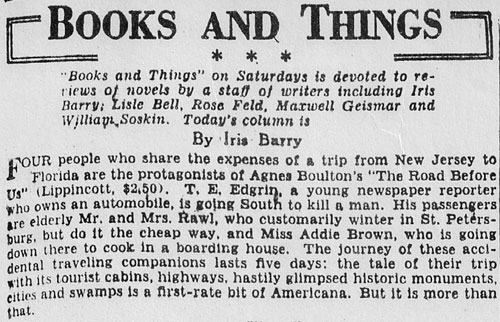 |
Book review
of Agnes Boulton's The Road Is Before Us,
Herald Tribune, October 21, 1944. |
 Chapter XVI
Chapter XVI |